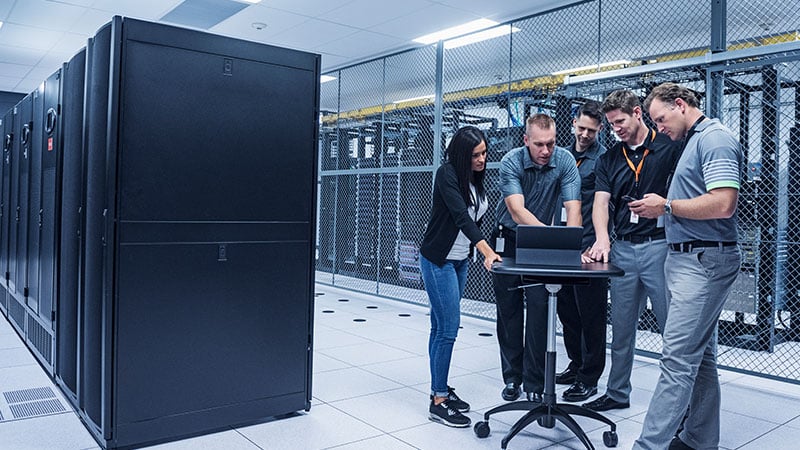Unlock the advantages that battery energy storage systems (BESS) bring: cost savings, energy resilience, and distributed energy resources (DERs).
As technology for critical digital infrastructure progresses and demand for data processing grows, data centers and enterprise facilities face increasing challenges. Rising power needs, infrastructure deployment delays, environmental impacts pressures, and the need for operational resilience are just some that come front and center.
Battery energy storage systems (BESS) have emerged as a key solution, addressing operational hurdles while delivering financial and environmental benefits. These systems are redefining energy strategies for facilities, making energy management smarter, more efficient, and cost-effective.
Addressing the demand for power
Data centers’ energy requirements, particularly hyperscale and edge data centers, require around-the-clock energy at unprecedented levels. This creates a heavy load on the traditional energy infrastructure, which often struggles to keep up.
Data center operators also face immense pressure to reduce deployment timelines, minimize costs, and achieve maximum uptime. Environmental and regulatory demands further complicate the picture, requiring data centers to adopt more responsible energy practices.
BESS offers an innovative way to meet these challenges. By managing energy more efficiently, these systems help data centers scale efficiently, avoid lengthy interconnection delays, and mitigate grid constraints.
The economic benefits of BESS
Traditionally, energy infrastructure in data centers was a cost center. Expenses were necessary to keep operations running but offered no direct financial benefits. BESS can change this paradigm and reimagine how the infrastructure contributes to the company’s bottom line and its community.
Turning costs into savings and revenue
Battery systems allow data centers to participate in energy markets, generating additional revenue. For example, a single BESS can provide services like frequency regulation or energy arbitrage, helping stabilize the grid while also creating a financial return. Consider this scenario: a 10 MW BESS in a deregulated energy market could potentially generate between $1.2 million and $1.5 million annually.
Beyond generating revenue, BESS enables cost savings in other areas. Peak shaving, demand-response programs, and time-of-use (TOU) rate arbitrage allow data centers to optimize their energy consumption during peak pricing periods, driving operational efficiency and reducing energy bills.
Government incentives and various state-level rebates can also potentially strengthen the case for BESS. These programs can significantly lower upfront costs, enabling data centers to achieve a simple payback in as little as three to five years.
| Service | Estimated annual value* |
|---|---|
| Frequency regulation | $1.2M–$1.5M |
| TOU arbitrage + demand charges | $0.6M–$1.0M |
| Utility program participation | $0.2M–$0.5M |
| Backup power (avoided outage costs) | Variable (event-driven) |
Table 1. A sample value stack estimation of a 10MW/four-hour BESS in 2025. This stack illustrates the potential annual value from common monetizable services. *Data center stacking strategy should be tailored to site-specific goals, market rules, and available programs. Source: CPower.
For more computation samples, return on investment (ROI) estimates, and total cost of ownership (TCO) models considering other factors such as capital expenses (CapEx), potential incentives and policy levers, payback period and internal rate of return (IRR), and other trade-offs to consider, download the white paper.
Enhancing performance and resilience
Outages can result in hefty financial losses, a damaged reputation, and potentially speed up equipment degradation. BESS provides backup power, facilitating operational continuity during grid failures.
Unlike traditional diesel generators, which rely on fuel supply chains and emit high levels of pollutants, BESS offers a cleaner, faster, and more reliable alternative. Battery systems activate within milliseconds, maintaining critical operations without interruption. For facilities managing high-density AI loads, this speed and reliability are a game-changer, keeping performance even under the most challenging conditions.
Timing BESS adoption: Why now?
Multiple factors contribute as the ideal moment for data centers to adopt battery energy storage systems now:
- Mature technologies: Advances in battery design and manufacturing have driven down costs while improving performance. BESS—along with the necessary peripherals, programs and platforms, and integrated systems—is now more accessible and dependable than ever.
- Regulatory incentives: Policies are driving investment interest in battery solutions, offering potential tax credits and financial incentives for early adopters.
- Rising energy demands: Data center construction is accelerating to meet growing workloads in AI, machine learning, and cloud services, amplifying the need for flexible energy storage options.
- Evolving grid markets: Deregulated energy markets offer new opportunities for battery systems to earn income by participating in grid-stabilizing programs, such as demand response and frequency regulation.
Take the next step: Maximizing the value of BESS
Adopting BESS can enable data centers to stay ahead of the curve in energy innovation while securing long-term cost benefits. Value stacking is a key strategy for data centers adopting BESS. By combining multiple benefits and revenue streams, facilities can optimize the return on their battery storage investments.
Advanced energy management systems and software are crucial in maximizing these benefits. Integrated equipment with sophisticated controls monitors batteries automatically as they shift between roles, based on real-time conditions and market opportunities. For instance, some of the largest data centers globally, operating at hyperscale levels, are already integrating battery systems to enhance capacity while replacing older, emissions-contributing technologies like diesel generators. These organizations provide a roadmap for other facilities looking to transform their approach to energy provision, collection, distribution, and utilization.







